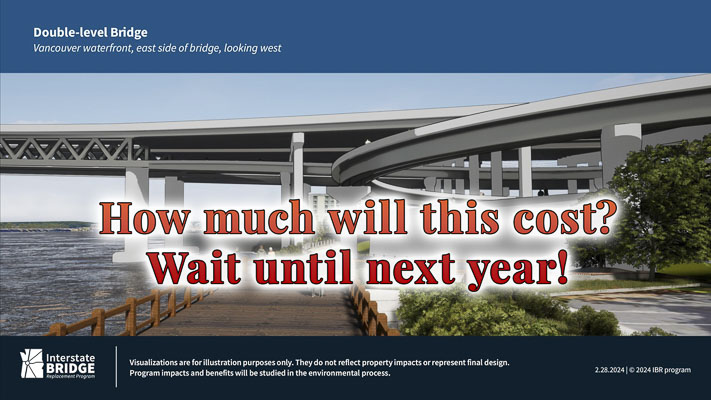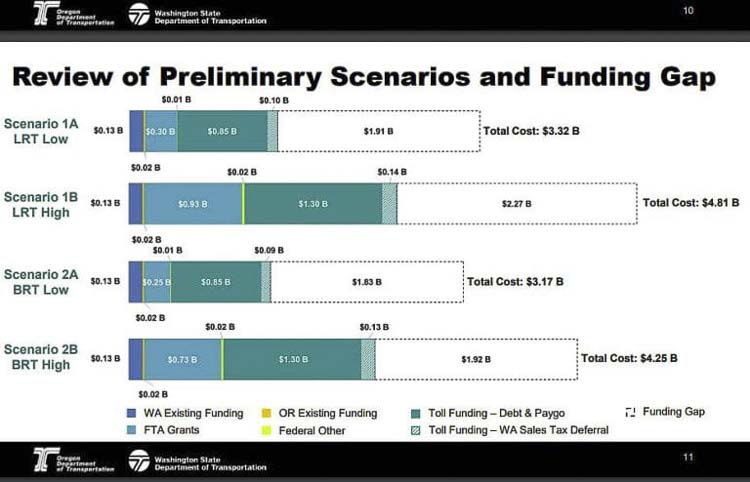
Price for the worst case scenario asked by Oregon Walks executive, worried about reducing project components
John Ley
for Clark County Today
The failed Columbia River Crossing (CRC) died largely due to the proposed tolling and light rail extension into Vancouver, along with increasing costs and lack of accountability. When Governor’s Jay Inslee and Kate Brown signed their memorandum, restarting efforts to replace the Interstate Bridge, they promised transparency and that the project would be “data-driven.” Today, one of the biggest questions surrounding the Interstate Bridge Replacement Program (IBR) is “how much will it cost?”
A year after the governor’s meeting, IBR Administrator Greg Johnson told legislators the cost estimate for constructing the replacement I-5 Bridge would range from $3.2 billion to $4.8 billion. Both high and low estimates included an extension of MAX light rail into Vancouver. Two years later they updated the cost estimates to $5 billion to $7.5 billion. Last December, Johnson told legislators the cost would be going up.
At the time, Oregon Sen. Lee Beyer told the 16 Oregon and Washington legislators: “that’s too high. Our reaction gives direction to the engineers to bring the number down.” Now that the price has doubled, he hasn’t demanded the project be trimmed to reduce the cost.
“What we may be learning and talking about today (November 2020) is that we can’t afford that,” Beyer said. “We have to have something less than that, if we’re going to get going.”
During a meeting of the IBR’s Community Advisory Group (CAG) on June 13, Johnson was asked a very direct question from Zachary Lauritzen, executive director of Oregon Walks. “What is the true worst case scenario number” for the seemingly endlessly rising costs. Johnson spoke about a lot of things, but ultimately revealed the updated cost estimate everyone has been looking for will come “this time next year.”
“What could really go sideways?” Lauritzen asked as follow up. He noted that the funding needs for the I-5 Rose Quarter project exceed the money the Oregon Department of Transportation (ODOT) has available. “Where does the revenue come from,” he asked, if costs explode.
The Rose Quarter project has increased 4-fold from an initial $450 million to nearly $2 billion. This is due to political promises made to the Albina neighborhood expanding the scope of the project, and ODOT mismanagement. Currently, the agency has roughly a $3 billion funding shortfall in trying to pay for transportation projects promised in the HB 2017 funding package.
Lauritzen noted that when costs explode, features or parts of a project can get cut. Johnson responded saying they wouldn’t be eliminating the bike, pedestrian or transit components, referring to the project’s Purpose and Need statement. Yet the recent revelation that over half the bridge structure will be for bikes, pedestrians and transit lends credence to Lauritzen’s concern that any cost cutting might reduce that real estate dedicated to active transportation.
Johnson spoke about their Cost Validation Estimating Process, which they had used to come up with the previous $5 billion to $7.5 billion cost range. He shared the high end was “if everything went sideways.” They’ve been sticking with the $6 billion number, expecting some parts would increase and other parts could be “value engineered” to save money. But for now, “we know the $6 billion number is going to rise,” he said.
The single largest component of the current $7.5 billion cost is the 3-mile MAX light rail extension, projected to be up to $1.9 billion. No one mentioned the details which include multiple facilities that could potentially be modified to save money.
Included in the proposal is a TriMet “overnight facility” near Expo. That is not considered a necessity for a replacement of the bridge. There is also the Vancouver waterfront transit stop, built at an estimated 75-80 feet above the ground and over an active rail line. There will be the Evergreen end of line stop just 2,500 feet north. No costs have been given for either Vancouver MAX stations.
But two components of the transit expansion are likely to raise eyebrows. TriMet is demanding a significant expansion of its Ruby Junction light rail maintenance facility in Gresham. That’s about 13 miles as the crow flies from the Interstate Bridge. It was also included in the failed CRC project.
Then there’s the demand from TriMet that the project include 19 new light rail cars. That would be over six cars per mile of the IBR proposal. TriMet recently completed their “Better Red” 10-mile expansion in Washington County. It asked for only four new light rail vehicles as part of the $215 million project.
On a per mile basis, there doesn’t seem to be a need for 19 new light rail vehicles. It appears TriMet is trying to load the cost of replacing old, worn out light rail cars onto the IBR project. Is that fair for Washington taxpayers to foot the bill for an expense TriMet knew was coming due for decades?

One can argue that there is no real need for either the Ruby Junction facility expansion or the new light rail vehicles to be part of the IBR. The program has not provided a cost breakdown for either of these components.
An added concern for taxpayers is TriMet’s demand for new taxes from people on both sides of the Columbia River. The IBR program has been silent on that issue. TriMet told Clark County Today it needed $21.6 million a year to cover operations and maintenance (O&M) of the three-mile extension. C-TRAN has stated they will not cover any of those costs.
The O&M funding TriMet is seeking would equal about $7.2 million per mile. In Fiscal Year 2022, TriMet spent $128.1 million on operations for its entire 60-mile MAX light rail system. That equals about $2.1 million per mile. Why is the IBR seeking over triple that amount? C-TRAN has never asked Oregon for revenue to cover its cross-river bus service.
Johnson mentioned his team meets bi-weekly with Coast Guard officials. They are demanding a bridge with at least the current 178 feet of clearance for maritime traffic on the Columbia River. The Coast Guard would prefer unlimited clearance that would be provided by a bascule bridge or a tunnel.
The IBR’s hope is to “mitigate” the harm done to river users. In the failed CRC, $86.4 million was offered to three up river manufacturers, including John Rudi at Thompson Metal Fab. Currently, the IBR is negotiating with four firms, but refuses to reveal how much taxpayer dollars are at stake.
In the past, Johnson has referenced a $400 million cost addition if they were to build a bascule bridge or one with a movable span. Up river firms are well aware of this number, giving them added negotiating power to raise the price of “mitigation.”
An additional concern is how much the current proposal will have to spend to buy residential and business properties in both Vancouver and Portland that will be taken. A public records request revealed 40 Vancouver homes and businesses, plus 35 floating homes on Hayden Island are in the crosshairs of the IBR.
What is the price for the project to buy these properties, so they don’t have to use eminent domain to forcibly take them? The median price of a Vancouver house is over $500,000. The 5 year old, six-story Hurley Development building is likely valued in the tens of millions. Is it fair for taxpayers to pick up the tab, especially when the project will deliver no traffic congestion relief?

“We’re not setting pre-conditions of type of high capacity (transit) systems,” Inslee said at the signing ceremony. “We’re going to be driven by data, it will be a very thorough analysis of the alternatives, and we’ll have a vigorous discussion in our constituencies to see what their thoughts are.” Clearly bus rapid transit would fit the bill, and would be much, much cheaper than a $666 million per mile light rail extension. Yet, light rail is being presented as the only option.
While most commuters in southwest Washington and northwest Oregon want congestion relief because they drive cars, the priorities for both governors put congestion relief last on their lists. IBR community surveys consistently reveal that 70 to 80 percent of people on both sides of the river want traffic congestion relief and saving time as their top priority. The Southwest Washington Regional Transportation Council reports there’s a “new normal” which includes significantly reduced transit ridership.
The IBR fails to deliver on that portion of the “Purpose and Need” statement. Program officials are telling drivers and freight haulers that morning travel times from Salmon Creek to the Fremont Bridge will double to an hour by 2045. Furthermore, they expect half of all rush hour traffic to be traveling zero to 20 miles per hour.
But legislators and taxpayers will have to wait another year for an answer to the “how much” question. Are they willing to wait or will they demand a serious cost cutting effort? Taxpayers should be asking “where’s the value” in all components of this project.
Also read:
- Expect delays on northbound I-5 near Ridgefield through May 9Northbound I-5 travelers near Ridgefield should expect delays through May 9 as crews work on improvements at the Exit 14 off-ramp to support future development.
- 6-cent gas tax hike central to new transportation deal in WA LegislatureA proposed 6-cent gas tax hike is central to a transportation funding deal under negotiation in the Washington Legislature, aimed at raising $3.2 billion over six years.
- Letter: C-TRAN Board improper meeting conductCamas resident Rick Vermeers criticizes the C-TRAN Board for misusing parliamentary procedure during a controversial vote on light rail.
- Opinion: TriMet’s ‘fiscal cliff’ a caution for Clark County taxpayersRep. John Ley warns that Portland’s financially troubled TriMet transit system could pose major risks to Clark County taxpayers as the I-5 Bridge replacement moves forward.
- Travel Advisory: Expect daytime delays on northbound I-5 near Woodland for guardrail repairs, April 18WSDOT will close the left lane of northbound I-5 near Woodland on Friday, April 18, to repair guardrail and improve driver safety.









